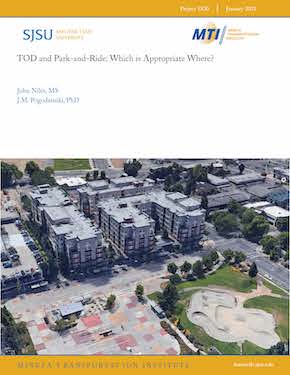- 408-924-7560
- mineta-institute@sjsu.edu
- Donate
TOD and Park-and-Ride: Which is Appropriate Where?
Despite the sharp drop in transit ridership throughout the USA that began in March 2020, two different uses of land near transit stations continue to be implemented in the United States to promote ridership. Since 2010, transit agencies have given priority to multi-family residential construction referred to as transit oriented development (TOD), with an emphasis on housing affordability. In second place for urban planners but popular with suburban commuters is free or inexpensive parking near rail or bus transit centers, known as park-and-ride (PnR). Sometimes, TOD and PnR are combined in the same development. Public policy seeks to gain high community value from both of these land uses, and there is public interest in understanding the circumstances and locations where one of these two uses should be emphasized over the other. Multiple justifications for each are offered in the professional literature and reviewed in this report. Fundamental to the strategic decision making necessary to allocate public resources toward one use or the other is a determination of the degree to which each approach generates transit ridership. In the research reported here, econometric analysis of GIS data for transit stops, PnR locations, and residential density was employed to measure their influence on transit boardings for samples of transit stops at the main transit agencies in Seattle, Los Angeles, and San José. Results from all three cities indicate that adding 100 parking spaces close to a transit stop has a larger marginal impact than adding 100 housing units. Previous academic research estimating the higher ridership generation per floor area of PnR compared to multi-family TOD housing makes this show of strength for parking an expected finding. At the same time, this report reviews several common public policy justifications for TOD as a preferred land development emphasis near transit stations, such as revenue generation for the transit agency and providing a location for below-market affordable housing where occupants do not need to have a car. If increasing ridership is important for a transit agency, then parking for customers who want to drive to a station is an important option. There may also be additional benefits for park-and-ride in responding to the ongoing pandemic.
JOHN S. NILES
John Niles is Founder and President of Global Telematics, a policy research consultancy based in Seattle that focuses on designing policies and actions for transportation improvement. As a Research Associate at Mineta Transportation Institute he has led team studies on transit oriented development, urban freight mobility planning, bus rapid transit, and park-and-ride productivity analysis. He is co-author of the textbook The End of Driving: Transportation Systems and Public Policy Planning for Autonomous Vehicles (Elsevier, 2018), as well as many technical reports and articles.
J. MIKE POGODZINSKI
Mike Pogodzinski is a Professor of Economics at San José State University and a Research Associate at Mineta Transportation Institute. His transportation research has included work on the employment impacts of high-speed rail construction, the impact on ridership of park-and-ride facilities, and the economics of bike sharing. He also does research on state rainy-day funds and the impact of municipalities on school performance.
-
Contact Us
San José State University One Washington Square, San Jose, CA 95192 Phone: 408-924-7560 Email: mineta-institute@sjsu.edu






